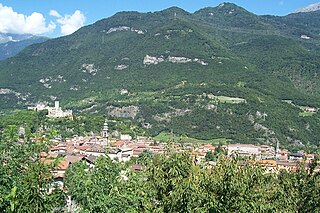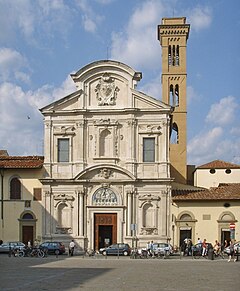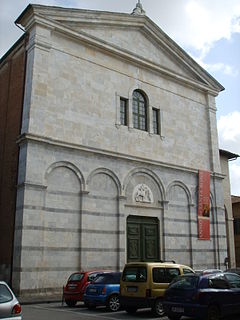
Masaccio, born Tommaso di Ser Giovanni di Simone, was a Florentine artist who is regarded as the first great Italian painter of the Quattrocento period of the Italian Renaissance. According to Vasari, Masaccio was the best painter of his generation because of his skill at imitating nature, recreating lifelike figures and movements as well as a convincing sense of three-dimensionality. He employed nudes and foreshortenings in his figures. This had seldom been done before him.

The Piazza dei Miracoli, formally known as Piazza del Duomo, is a walled 8.87-hectare area located in Pisa, Tuscany, Italy, recognized as an important centre of European medieval art and one of the finest architectural complexes in the world. Considered sacred by the Catholic Church, its owner, the square is dominated by four great religious edifices: the Pisa Cathedral, the Pisa Baptistry, the Campanile, and the Camposanto Monumentale. Partly paved and partly grassed, the Piazza dei Miracoli is also the site of the Ospedale Nuovo di Santo Spirito, which houses the Sinopias Museum and the Cathedral Museum.

Breno[ˈbreːno] is an Italian comune of 4,986 inhabitants in Val Camonica, province of Brescia, in Lombardy.

The Basilica of Saint Francis of Assisi is the mother church of the Roman Catholic Order of Friars Minor Conventual in Assisi, a town in the Umbria region in central Italy, where Saint Francis was born and died. It is a Papal minor basilica and one of the most important places of Christian pilgrimage in Italy. With its accompanying friary, Sacro Convento, the basilica is a distinctive landmark to those approaching Assisi. It has been a UNESCO World Heritage Site since 2000.

The Basilica of San Petronio is a minor basilica and church of the Archdiocese of Bologna located in Bologna, Emilia Romagna, northern Italy. It dominates Piazza Maggiore. The basilica is dedicated to the patron saint of the city, Saint Petronius, who was the bishop of Bologna in the fifth century. Construction began in 1390 and its main facade has remained unfinished since. The building was transferred from the city to the diocese in 1929; the basilica was finally consecrated in 1954. It has been the seat of the relics of Bologna's patron saint only since 2000; until then they were preserved in the Santo Stefano church of Bologna.

San Pietro in Montorio is a church in Rome, Italy, which includes in its courtyard the Tempietto, a small commemorative martyrium (tomb) built by Donato Bramante.

The Basilica of San Frediano is a Romanesque church in Lucca, Italy, situated on the Piazza San Frediano.

San Carlo ai Catinari, also called Santi Biagio e Carlo ai Catinari is an early-Baroque style church in Rome, Italy. It is located on Piazza Benedetto Cairoli, 117 just off the corner of Via Arenula and Via dei Falegnami, a few blocks south of the church of Sant'Andrea della Valle.

Diano Castello is a comune (municipality) in the Province of Imperia in the Italian region Liguria, located about 90 kilometres (56 mi) southwest of Genoa and about 5 kilometres (3 mi) northeast of Imperia. As of 31 December 2004, it had a population of 2,061 and an area of 6.0 square kilometres (2.3 sq mi).

The chiesa di San Salvatore di Ognissanti or more simply chiesa di Ognissanti, is a Franciscan church located on the piazza of the same name in central Florence, region of Tuscany, Italy. Founded by the lay order of the Umiliati, the church was dedicated to all the saints and martyrs, known and unknown.

Sant'Onofrio al Gianicolo is a titular church in Trastevere, Rome. It is the official church of the papal order of knighthood Order of the Holy Sepulchre. A side chapel is dedicated to the Order and a former grand master, Nicola Canali is entombed there. It is dedicated to Saint Onuphrius and located on the Janiculum.

Santa Maria del Carmine is a church of the Carmelite Order, in the Oltrarno district of Florence, in Tuscany, Italy. It is famous as the location of the Brancacci Chapel housing outstanding Renaissance frescoes by Masaccio and Masolino da Panicale, later finished by Filippino Lippi.

San Piero a Grado is a church in Pisa, Tuscany, Italy, in the eponymous frazione 7 kilometres (4.3 mi) west of the city center. The church is located where once was a now disappeared port of the Pisan Republic, where, according to the legend, St. Peter landed in Italy from Antiochia in 44 AD.

San Francesco de' Ferri is a church in Pisa, Tuscany, Italy.

Pistoia Cathedral, or Cathedral of Saint Zeno is the main religious building of Pistoia, Tuscany, central Italy, located in the Piazza del Duomo in the centre of the city. It is the seat of the Bishop of Pistoia and is dedicated to Saint Zeno of Verona.

San Martino is a Roman Catholic church in Pisa, region of Tuscany, Italy, facing piazza San Martino, on the left bank of the Arno river.

San Francesco d'Assisi is a Baroque style, Roman Catholic church located on via San Francesco d'Assisi in Turin, region of Piedmont, Italy. The church of San Rocco is on the same street.

San Francesco is a Romanesque and Gothic-style, Roman Catholic church located at Piazza San Francesco in Pescia, region of Tuscany, Italy.
San Girolamo is a 15th-century Roman Catholic church located in Spello, province of Perugia, region of Umbria, Italy.

San Nicolò is a Romanesque and Gothic-style, Roman Catholic church in Padua, region of Veneto, Italy. It stands in front of a homonymous piazza, and is adjacent to the Palazzo Meschini and Palazzo Brunelli-Bonetti.



















